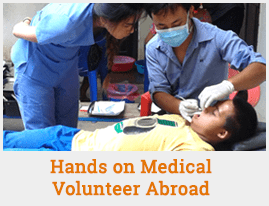VOLUNTEER IN COSTA RICA
' I LOVE this experience in chitwan for though short period! '
Xue Ying Fiona WangThis project is currently unavailable.
Wildlife Volunteer Opportunity in Costa Rica
The Most Affordable
Volunteer fees starting at just
$210
The Most Reputed
Since 1998, over 18,000 Volunteers, hundreds of online reviews
The Most Transparent
No Middlemen. Pay your fees directly to host families and projects.
Project Summary
Are you an animal lover with an adventurous spark? Do you want to spend time in a beautiful tropical destination while helping displaced, injured, or victimized wildlife as a wildlife volunteer in Costa Rica? Are you also searching for an affordable and safe way to travel to Costa Rica?
The wildlife and macaw sanctuary where this amazing Costa Rica wildlife refuge volunteer program takes place was created in 1994 by Mainor Khayyan and Rodolfo Orozco, two native Costa Ricans with an affinity for animals, especially wild parrots. Costa Rica is home to both the chromatic Scarlet Macaw and the Great Green Macaw, as well as several other species of wild parrots.
Get More Info NowThe sanctuary was founded as a result of the constant threat that was noticed to the macaws, as well as many other species of wildlife in Costa Rica due to habitat destruction, the illegal pet trade, and other devastating human influences. Volunteering at the wildlife sanctuary in Costa Rica is an incredible opportunity where you will have the chance to work up close and personally with a variety of amazing exotic animals. Your dedication to this inspiring wildlife volunteer project in Costa Rica will truly make a difference in the lives of all the animals that now call the sanctuary home.
There are many animals in the sanctuary that will never be able to return to the wild because of the physical and psychological turmoil that they have faced. However, some animals recover fully and are only temporary residents. Whatever the case may be, there is always a great need for compassionate animal lovers to join this exciting hands-on wildlife volunteer program in Costa Rica.
Wildlife Volunteer Activities in Costa Rica
There are six different wildlife volunteer opportunities in Costa Rica at the wildlife and macaw sanctuary. These wildlife volunteer projects in Costa Rica are ongoing and are open to volunteers who want to help the resident animals who have ended up there for one reason or another. It is possible to volunteer within multiple projects.
Macaw Conservation Project
Through rescue, rehabilitation, and breeding efforts, the sanctuary is working tirelessly to help protect and reintroduce healthy populations of macaws back into the wild. On top of working directly with the macaws, the project facilitates reforestation, environmental education, and ecotourism programs. Wildlife conservation has many layers and by joining this wildlife volunteer project in Costa Rica, you will be helping to make sure that all of these layers are operating to their fullest potential.
Displaced and Distressed Wildlife Protection Project
For the past fifteen years, this sanctuary has been offering a safe and nurturing place for ocelots, jaguars, tapirs, and other native Costa Rican creatures. The sanctuary is harmoniously placed on a 15-acre remote piece of private property. When you take part in these wildlife volunteer activities in Costa Rica, you will be helping to care for these helpless animals and give them the best possible chance of returning to the wild or living out their days in peace and happiness at the sanctuary.
Get More Info NowEcological Restoration Project
The sanctuary has also been working since 2000 to plant and grow a protected forested area for the resident animals and native animals of the surrounding area. The trees that have been planted have provided a safe habitat for hundreds of macaws, parrots and other birds, sloths, iguanas, and monkeys, among other animals. The restoration and maintenance of this exclusive forest is an ongoing effort and wildlife volunteers in Costa Rica are constantly needed to help.
Wildlife Rescue Project
The wildlife sanctuary takes in confiscated animals from the System of National Areas of Conservation (SINAC), the national police and fire departments, and from local civilians. The influx of animals to the sanctuary is very steady. Some animals have been orphaned, injured, displaced from their natural habitat, or were once an illegal pet. The care that these animals need expands across a broad spectrum. When you work with this wildlife volunteer program in Costa Rica, you will be involved in all different activities and tasks to help these wonderful creatures.
The wildlife sanctuary currently has a designated area for keeping rescued animals, a neonatal care center, a veterinary clinic, a quarantine zone, a food preparation area, a residential area, and a large bird enclosure. As a wildlife volunteer in Costa Rica, there are so many different areas that you can volunteer your time and energy to.
Eco Tourism Project
Another amazing part of this wildlife sanctuary in Costa Rica is the ecotourism experience that they have developed. This is a grand effort to educate visitors about the native species of Costa Rica and the troubles that they are facing, as well as to share the conservation, rescue, rehabilitation, release, and reforestation activities that are taking place every day at the sanctuary. Visitors will spend their time with an experienced guide who will take them through the sanctuary and share with them a wealth of fascinating information.
Reforestation Project
Jabillo, guayacan, surá, and jobo trees are native to Costa Rica and have been planted on the protected sanctuary land to provide a safe haven for monkeys, birds, deer, and other rescued animals that are unable to be released into the wild. The aim of this specific project is to recreate the natural habitat of the animals who have been displaced from theirs.
What are my roles as a wildlife volunteer in Costa Rica?
When you join this wildlife volunteer program in Costa Rica, you will have a multitude of responsibilities. While this Costa Rica wildlife refuge volunteer program is very hands-on, that doesn’t mean you will be loving on and interacting with the animals like they are your pet. Remember, one of the goals of this sanctuary is to try and return as many animals as possible back to the wild.
This unique wildlife volunteer opportunity in Costa Rica is a chance to positively impact the lives of rescued wild animals and help the sanctuary perform its necessary duties and operations while also experiencing a new country, new culture, and new language. Your specific roles will depend on the specific needs of the sanctuary at the time of your volunteer period, as well as your personal interests and volunteer goals.
Your responsibilities can include things like feeding the animals, cleaning the enclosures, helping with animal emergencies, participating in the rehabilitation of the animals, planting trees and plants, assisting with eco tours, lending a hand with construction projects, and tending to agricultural productions.
Accommodations at the Costa Rica Wildlife Sanctuary Volunteer Project
Accommodations at the Costa Rica Wildlife Sanctuary Volunteer Project
As a wildlife volunteer in Costa Rica, you will stay in a designated volunteer house that has bunk beds. You will have your own bed and personal space within the house. The house does not have air conditioning but does have a fan to ensure your comfort.
Services for wildlife volunteers in Costa Rica
- Wi-Fi access from 12 pm – 2 pm and after 5 pm. In case of an emergency, exceptions will be made.
- Taxi or public bus transportation
- A small general store is a short walk one kilometer walk from the sanctuary
- All meals are provided for volunteers. Vegetarian options will be provided upon request.
- In case of an emergency, the closest hospital is 40 minutes away.
The Sanctuary Rules
The wildlife sanctuary has a strictly enforced set of rules that all volunteers must adhere to. Failure to honor the rules could result in expulsion from the wildlife volunteer program in Costa Rica.
Get More Info NowThe following rules are directly from the wildlife sanctuary:
- No smoking inside of or around the sanctuary.
- Do not talk to any animals.
- No feeding the animals (outside of feeding time).
- Dispose of garbage properly.
- When taking photos, the use of flash is forbidden.
- The use of any kind of drug is forbidden.
- No alcoholic beverages are allowed at the sanctuary.
- Be respectful towards the sanctuary staff (no sexual harassment, racism or xenophobia would be tolerated).
- NEVER leave the sanctuary facility alone.
- Respect the personal belongings of others (food supplies, cell phones, bags, etc.).
- Bringing outsiders into the project is forbidden.
- Maintain appropriate dress code including long pants while working.
- Follow security rules according the activity (gloves, helmet, eye glasses, boots, pants).
- Cell phones may only be used between 12:00 pm – 2:00 pm and after 5:00 pm.
- Do not leave electronic devices or personal objects in common areas.
- The use of any kind of aerosol is forbidden.
- Do not enter the dorms or any other sanctuary common area with dirty shoes.
- Soap, shampoo, toothpaste, detergent and other hygiene products MUST be biodegradable.
- The use of insect repellent containing DEET is STRICTLY prohibited.
- Maintain hygiene in the bathrooms.
- Music can be listened to through the use of headphones OR at a low volume (to not disturb one another or the animals).
- Do not leave tools in any common areas.
- Do not leave clothes lying on the floor (order in general).
- Dispose of sanitary napkins properly (women).
- Lights must remain off during sleeping hours (10:00 pm – 5:00 am).
How to travel to the wildlife volunteer project in Costa Rica
The most cost-effective way to get to the sanctuary after you arrive in Costa Rica is to take the public bus from the town of Puntarenas to the sanctuary. The buses run every day except on Sundays. The bus leaves from Puntarenas at 11:30 and will get you to Aranjuez, where the sanctuary is located around 1:00. On the reverse side, the bus leaves from in front of the sanctuary at 6am to go back to Puntarenas. This bus ride costs approximately 1,000 colones or $2.
A taxi service can be arranged from Puntarenas to the sanctuary, as well, but at a cost of around $35. A taxi from the Juan Santamaria International Airport to the sanctuary cost around $80.
 1-2543048951
1-2543048951



